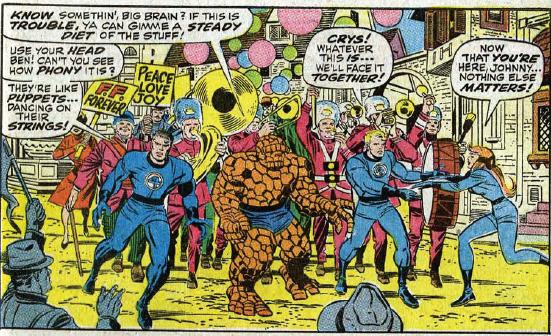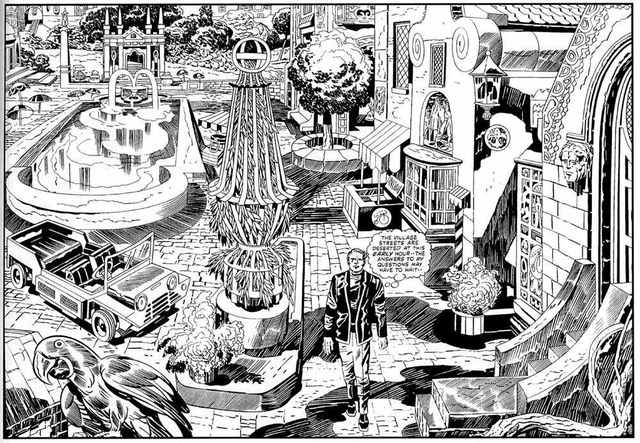The 10 Greatest Examples of The Prisoner’s Enduring Pop Culture Legacy
 |
?When The Prisoner originally aired in the UK and US in the late 1960s, it perfectly reflected the chaos and change of the time. However, few could have predicted that the show’s themes would continue to resonate some 40 odd years later. Well, except for Patrick McGoohan. As the visionary mind behind the series, he found a way to incorporate his ideas about topics ranging from the speed at which society moves to free will into a series that was equally entertaining and smart. It was also extraordinarily strange. Let’s face it, any show whose primary aggressor is a gigantic weather balloon nicknamed Rover isn’t your typical TV viewing. And that’s something to be thankful for indeed. What it offered viewers was a pastiche of big ideas hidden in what seemed to be populist viewing. You know how when you were a kid your mom mixed your aspirin into applesauce to make it more palpable? That’s a fitting analogy for what McGoohan tried to accomplish with The Prisoner. It worked beautifully, so much so that writers, producers and other artists continue to draw inspiration from it. Today’s Daily List examines 10 ways in which the series has impacted pop culture. Some are silly, other profound. But in their own style, they each reflect how much McGoohan’s show has resonated — and continues to — with viewers across the globe.
Before we begin, you’ll notice that this list is completely lacking of any Prisoner-related music. That was a conscious choice, as songs/bands/videos inspired by the show easily merit lists of their own. If you have a problem with this, perhaps it’s best to remember the old Village maxim that “a still tongue makes a happy life.” Also, this list will not be pushed, filed, stamped, indexed, briefed, debriefed, or numbered. With that said, let’s begin.
10) Renault 21 Ad
With its weird mute butler, commentary on the importance of maintaining your individuality in a world where conformity dominates, and, well, ape masks, The Prisoner is hardly typical advertising fodder (unless of course there’s a Village Foods cannery out there somewhere). So this 1980s commercial for the Renault 21 is more than a bit baffling. As far as I can tell, there’s no reason for this to exist other than to let the creative team behind it live out their secret agent resignation fantasies. It also doesn’t help matters that the French sedan being pitched here is shockingly lame when compared to the Lotus Seven actually featured in the series. It’s been awhile since I’ve revisited the series, but was “embrace inferiority” one of the Village’s maxims? If so, this ad is starting to make more sense.
9) The Laughing Prisoner
In 1987, British musician and TV personality Jools Holland decided to create a one-off special that would allow him to spotlight bands he liked while paying tribute to one of his favorite shows. The result was The Laughing Prisoner, a weird program that takes a Star Wars Holiday Special approach to McGoohan’s masterpiece. It features clips from the series intercut with new segments in which Holland finds himself stuck in the Village after walking away from his music video show. His quest for answers leads to cheap gags and music from the likes of XTC and Siouxsie and the Banshees (if you are the type of person who still obsesses over MTV’s 120 Minutes, the sight of Andy Partridge in a piped blazer alone is worth tracking this down for). British comedy nerds will be pleased to know that Stephen Fry and a pre-House Hugh Laurie co-wrote this and also appear — though don’t be too hard on them for the cheesy jokes that permeate the program. Because this was filmed at the Portmeirion site in North Wales that also served as the Village in The Prisoner, the whole show takes on an air of legitimacy. Self-indulgent? It sure is, but it’s also essential viewing for anyone who happens to love the series and 1980s Britpop.
8) Comic Book Tributes
 |
?The best example of The Prisoner‘s impact upon the comics industry is Shattered Visage, DC’s officially sanctioned follow-up that would have made a much better AMC series than the network’s muddled remake. It was hardly the first time that Number 6’s adventures have been paid homage to in comics though. Back in 1969, Reed Richards, The Thing, Johnny Storm and Crystal found themselves, um, prisoners in a Doctor Doom’s oddly familiar Latverian village in Fantastic Four issues 84 to 87. These were illustrated by Jack Kirby, a huge fan of the series who was subsequently given the chance to write and draw an ongoing The Prisoner comic for Marvel in 1976. Take a look at his version of the Village:
 |
?
Fuck and yes. Sadly, the project was scrapped before the first issue hit stores. A quick Internet search yields a treasure trove of art from the aborted project, which was a straightforward adaptation of “Arrival.” Whether or not future installments would have been based on additional episodes or branched off into original stories a la Kirby’s awesome/insane work for Marvel’s 2001: A Space Odyssey (from the same time period) remains a mystery. That minor tragedy aside, Prisoner references both blatant and subtle — such as Wolverine tooling around in a Lotus Seven — still turn up in comics frequently.
7) Coupling, “Nightlines”
Before Doctor Who, Stephen Moffat won acclaim for his work on the Britcom Coupling. In the show’s nerdiest episode, “Nightlines,” notorious womanizer Patrick has a dream inspired by The Prisoner that quickly devolves into a sexual fantasy at a car wash (it is at this point in this entry I originally tried to make a joke comparing women’s breasts to Rover and failed miserably. Sorry). You can see this sequence in its entirety above, though you should check out the entire episode for an early taste of Moffat’s Who obsession — including Nicolas Briggs voicing a Dalek toy.
6) Battlestar Galactica
Did you know that each time you masturbate to Tricia Helfer on Battlestar Galactica you are actually paying tribute to The Prisoner? Yep! Ron Moore named her Number Six as a homage to Patrick McGoohan’s character in the series. Okay, it’s a pretty obvious fact, yet still (literally) one to grow on. Amirite, fellas?
—-
5) Babylon 5
You’ve got Star Trek in my Babylon Five! You’ve got Babylon Five in my Prisoner! Thus we have this nerd-baiting clip in which several genre properties get blended together to form one deliciously geekiy viewing experience. I am not a number! I am Chekhov!
4) G.I. Joe, “There’s No Place Like Springfield”
Written by Howard the Duck creator Steve Gerber, the two-part G.I.Joe episode “There’s No Place Like Springfield” had Shipwreck awaking after an injury in a seemingly idyllic town called Springfield. (His address? 6 Village Drive, natch.) Stricken with amnesia, he finds himself struggling to cope with a new life — including a wife and daughter — he is completely unfamiliar with. Then his fellow Joes start attacking him and turning to puddles of goo before his very eyes. Before you can say “Dry Bones” he realizes that he is trapped in a Cobra mindfuck that was created as a means to extract the secret ingredient of a formula hidden in his brain that can weaponize water. If the plot seems like something straight from the mind of Number 2, that’s no surprise. It takes several pages from The Prisoner‘s playbook, resulting in one of the most complex G.I. Joe installments to air during the series’ run.
Okay, the only complex one.
3) Reboot, “Number 7”
Long before he became the subject of fanboy loathing over at DC Comics, Dan DiDio demonstrated his geek knowledge by writing the above episode of ReBoot that honors The Prisoner. What is especially interesting about this is how any kids watching had to be utterly confused once the hardcore references to the show started getting bandied about (the episode is especially heavy on nods to “Fall Out,” which was easily the most esoteric hour of TV of the 1960s). Likewise, any Prisoner fans who were tuning in to ReBoot for the first time to see the shoutouts to their beloved series also found themselves completely in the dark. Unless you happen to be a fan of both properties, you’ll be at a loss to what’s going on here. And you thought DiDio’s upcoming DC reboot was obtuse…
2) The Simpsons, “The Computer Wore Menace Shoes”
Reclusive Simpsons scribe John Swartzwelder wrote this twelfth season episode in which Homer’s internet rumor-mongering gets him drugged and exiled to “the Island.” It is there that he encounters Number Six (voiced by Patrick McGoohan) and embarks on a characteristically bumbling quest to return home. Swartzwelder is widely considered to be one of the best writers of The Simpsons — his other efforts include series high points “Itchy & Scratchy Land” and “Whacking Day” — and this installment doesn’t disappoint. Not merely just a sharp parody of The Prisoner, it also presents a respectable skewering of internet gossip culture and those who get swept up in it. But perhaps the greatest triumph of “The Computer Wore Menace Shoes” is that it actually got the blessing and involvement of Patrick McGoohan, a man who was frequently reported to be as ornery as he was gifted. It’s a delight to see him have a sense of humor about himself and return to his signature role, even if it was just to goof on it.
1) Lost
As tempting as it was to put one of McGoohan’s self-aware Columbo guest spots in this top spot, I resisted and opted to give it to Lost. Whether you loved the series or not, there’s little debate over the fact that the series generated some pretty passionate conversation amongst viewers. On a surface level, you can point to the fact that both The Prisoner and Lost feature characters who are thrust into an environment they desperately desire to escape from where they encounter labyrinthine plotting against them. Then there’s the argument that (at least initially) Rover and the Smoke Monster seemed to serve the same purpose on both shows. Yet the similarities between the two shows go much deeper. At times, both made audiences feel that they were witnessing an arm wrestling match between Orwell and Kafka. Mindfucks were the order of the day on the Island and in the Village, and each of the series attempted to expand the horizons of the viewers. I have no doubt that many of you will take me to task to this in the comments, but think about how Lost redefined serialized storytelling for the modern age. How many other recent shows enthralled and frustrated you the way Lost did. Were you pissed about how it ended? Well, legend has it that fans were so upset with The Prisoner‘s conclusion that McGoohan went into hiding. It’s a very dramatic story (that kinda reeks of bullshit), but it’s existence punctuates how passionate people felt about the series. The same way people still feel about Lost. Clearly of the two shows Lost was much more of a mainstream show, and as such isn’t nearly as intellectual as The Prisoner. That doesn’t mean they can’t and don’t share the same thematic DNA. During Lost‘s run, both Damon Lindelof and J.J. Abrams cited The Prisoner as a huge influence. If McGoohan’s subversive classic never hit the air, would it, or any other number of genre shows, ever have hit the air? It’s impossible to say, but I’m guessing no. Feel free to disagree with me now. And, oh yeah, be seeing you!
